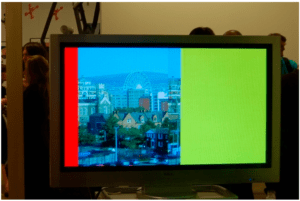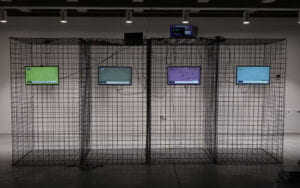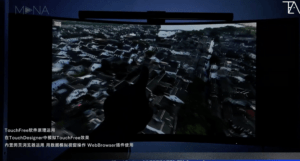Preparatory Research & Analysis
After reading “Art, Interaction and Engagement” by Ernest Edmonds, my definition of how interaction should truly behave was elevated. Throughout the article, the author continuously addresses his concerns about ‘the nature of interaction itself’ (16, Edmonds). He walks us through examples, explaining his personal insights and opinions regarding their interactive state. Some of these works discussed were the Shaping Form, Cities Tango, JigSaw, etc (Edmonds). Personally, I think that the Cities Tango appealed the most to me. Furthermore, it seems to fit the interaction criteria with little to no flaws. Edmonds exclaimed, “The work is ‘attracting’ in the sense that a dynamic
display including images from afar is shown. It is ‘sustaining’ in part by nature of the revealing of the real-time images that often include pictures of participants in the other city”. Overall, this article was very informative and opened my eyes to a new definition of interaction.

Thinking about potential interactive ideas, I went back to our old document with resources to help me. Also, I used http://creativeapplications.net to help me find creative and interactive projects. The first example I want to discuss is The March by Aleksiej Cecocho. Here, “Every “channel” speaks to us in an incomprehensible bubble framed in a completely random, derivative, and abstract language of visual communication” (Cecocho). There are four screens in the presentation, with each displaying bubbles depending on the location where the user stands. For me, this is a successful interaction as the machine listens to the user, thinks, & then responds.
Though, this is basic definition. Using what Edmonds stated, this work is attracting, sustaining, & also relating. The theme of this project is a study of the relative presentation of events by the media that forms post-truth (Cecocho). Therefore, it talks about a deep message while also attracting the viewer’s eyes. As this project was created using Processing, I think that this will inform my work. If possible, I would incorporate a multi-screen interaction as well. Also, I think that this aspect is successful as the interaction could be directly reflected on the screen. In a sense, this is the art that reflects a personal message. To me, this is successful as the author gets through his point, using a form of interaction. Here is his personal website: http://aleksiejcecocho.pl/projects/march/

The second idea came from the source https://www.manamana.net/, a predominately Chinese website filled with interaction designs and project creations. During it, I managed to find something that personally appealed to me. In this video, the interaction is between the user & the screen. It is called ‘Touch Designer‘. There are different programs shown, such as a music-listening platform, & several other visual art platforms. Depending on the user’s hand motions, the device is able to respond (think) and carry out (answer) the action. This inspires me as it is very futuristic, and a possible future-reality thing that we could have.
Also, I think that the interaction here is fantastic. It fits Edmonds criteria again as it’s all attracting, sustaining, & also relating. It’s directly correlated with our current technology, ensuring its sustainability and relatedness. By developing this more, it might be possible in the near future for everyone. Also, it’s extremely interactive and attractive to fidget with. Personally, I would like to explore elements of this project in my final. I believe that perhaps I could use Arduino to hook wires to the user (as in Workout Recitation), then reflect that ‘motion’ onto the screen. This could involve their entire body, arms, or just hands as used in this video. Overall, I think that these two examples exemplify what successful interaction is, & how they could potentially connect to my final project.

Lastly, my previous definition of a successful interaction project experience was simply people/machines listening — then thinking, & responding in some form/shape. This was concluded after using articles by Crawford, Manovich, & Igoe. Broadly speaking, it is interaction. However, my perception has slightly changed after reading Edmonds’ article. For me, successful interaction is a project that is attracting, sustaining, & relating in terms of experience, but isn’t mandatory facilitated and can communicate using its own response system in an effective amount of time (Edmonds). I think that an interactive project should have sustainability, meaning that the experience can change over time. Also, it should have traits that create long-term engagement, Edmonds notes, “The sustaining’ element of these works is not intended to come through interaction al all, but relies on their intrinsic aesthetic interests.” To me, the project’s long-term engagement should come from a mix of interaction and aesthetics, and not solely the former. Also, it should not have people constantly facilitating. If the interaction cannot run independently without an instructor constantly managing it, the sense of interaction decreases. Only by accomplishing all these factors, will a successful interactive project be created!
Leave a Reply